Table of Contents
ToggleDo you need help maximizing customer retention on your SaaS platform?
If so, you’re not alone. It’s easy to focus on acquiring customers and miss out on connecting with them in meaningful ways that lead to customer loyalty.
But what if there was a way to make sure your relationships with customers go deeper…that once they become users of your product, they’d stay with you for the long haul?
That’s where mapping the customer journey comes in. In this article, we’ll explain why it’s important for SaaS companies to map the customer journey, discuss how to do it effectively and provide guidance on how organizations can leverage their understanding of this journey for customer success.
Customer journey mapping for SaaS companies
Customer journey mapping is a powerful tool for SaaS companies to help them better understand their customers and improve their overall customer experience. It involves visualizing a customer’s different touchpoints with your product or service, from initial awareness to purchase and post-purchase.
To create a practical customer journey map, SaaS companies must research to identify the critical stages of the customer journey, such as awareness, consideration, purchase, and retention. They can then use this information to visually represent the customer journey, highlighting key touchpoints and pain points.
By understanding the customer journey, SaaS companies can identify areas to improve the customer experience and increase customer satisfaction. For example, they may discover that customers need help during the onboarding process or that they need to receive adequate support after purchase.
Customer journey mapping is essential for SaaS companies that want to optimize the customer experience and build long-term customer relationships.
Importance of customer journey mapping for SaaS companies
Customer journey mapping is crucial for SaaS companies for several reasons.
- Firstly, it helps companies better understand customers’ needs, preferences, and pain points at every customer journey stage. This understanding allows SaaS companies to develop more personalized and targeted marketing and sales strategies, which can improve customer engagement and ultimately lead to higher customer acquisition and retention rates.
- Secondly, customer journey mapping enables SaaS companies to identify areas of the customer journey that need improvement. By analyzing customer feedback and data, companies can pinpoint pain points and bottlenecks in the customer journey and develop solutions to address them. This leads to a smoother and more enjoyable customer experience, which leads to increased customer loyalty and advocacy.
- Finally, customer journey mapping helps SaaS companies to prioritize their resources and investments. By identifying the most critical touchpoints in the customer journey, companies can allocate their resources more effectively, focusing on the areas that will significantly impact customer satisfaction and business outcomes.
Customer journey mapping is a powerful tool that can help SaaS companies to improve customer satisfaction, increase customer acquisition and retention rates, and ultimately drive business growth.
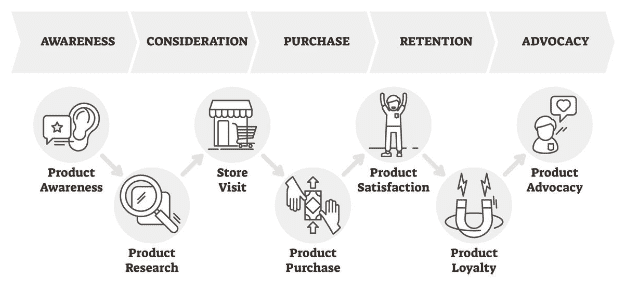
Understanding the Customer Journey
Understanding the customer journey is essential for SaaS companies that want to build successful, long-term relationships with their customers. The customer journey is the process a customer goes through when interacting with a company, from initial awareness to post-purchase support.
To understand the customer journey, SaaS companies must gather data and insights about their customer’s behaviors and preferences at every stage. This may involve analyzing customer feedback, conducting surveys and interviews, and using analytics tools to track user behavior on their website or product.
Once a SaaS company understands the customer journey, it can use this information to develop targeted marketing and sales strategies that address customers’ needs and pain points at each journey stage. For example, they may create personalized onboarding experiences for new customers or provide targeted support and resources for customers experiencing difficulties with their products.
Understanding the customer journey is critical for SaaS companies that want to improve customer satisfaction and retention rates. By providing a seamless and enjoyable customer experience at every stage of the trip, companies can build trust and loyalty, leading to increased revenue and long-term business success.
Awareness
Awareness is the first stage of the customer journey, where potential customers become aware of a SaaS company’s product or service. SaaS companies must create brand awareness and generate interest in their product or service during this stage.
To create awareness, SaaS companies can use a variety of marketing tactics, such as content marketing, social media marketing, and paid advertising. For example, they can create informative blog posts, videos, or social media content that educates potential customers about their product or service and its benefits.
In addition to creating awareness, SaaS companies must establish their credibility and differentiate themselves from competitors during this stage. This can be achieved by showcasing customer testimonials, industry awards, or other forms of social proof that demonstrate the value and effectiveness of their product or service.
The awareness stage is critical for SaaS companies that want to attract new customers and grow their business. By creating effective marketing campaigns that educate and engage potential customers, companies can generate interest and establish themselves as credible and trustworthy providers of their products or service.
The stage of awareness in the customer journey
The awareness stage in the customer journey is where potential customers become aware of a SaaS company’s product or service. During this stage, customers are often just beginning to explore their options and may still need to look to make a purchase actively.
To attract and engage potential customers during the awareness stage, SaaS companies must focus on creating brand awareness and generating interest in their products or service. This can be achieved through various marketing tactics, including content marketing, social media marketing, and paid advertising.
Content marketing involves creating high-quality content, such as blog posts, articles, or videos, that educate and inform potential customers about the benefits of a SaaS company’s product or service. Paid advertising involves running targeted ads on platforms like Google Ads or Facebook Ads to reach potential customers. Social media marketing involves using social media platforms like Twitter, LinkedIn, or Instagram to engage with potential customers and build brand awareness.
During the awareness stage, SaaS companies must establish credibility and differentiate themselves from competitors. This can be achieved by showcasing customer testimonials, industry awards, or other forms of social proof that demonstrate the value and effectiveness of their product or service.
The awareness stage is critical in the customer journey, laying the foundation for future customer interactions and engagements. By creating effective marketing campaigns that educate and engage potential customers, SaaS companies can generate interest and establish themselves as credible and trustworthy providers of their products or service.
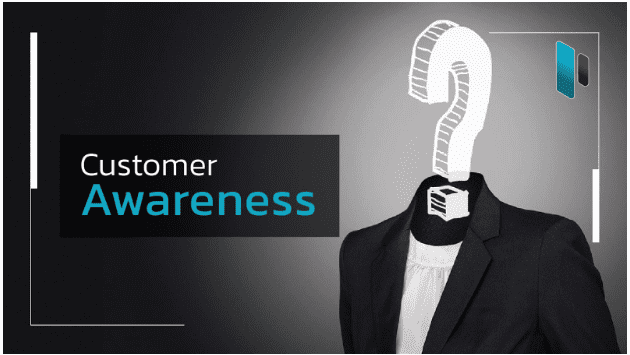
How customers become aware of your product or service?
Customers can become aware of a SaaS company’s product or service through various channels and touchpoints. Here are some ways customers can become aware of your product or service:
- Search engines: Customers often use search engines like Google or Bing to research products or services. Optimizing your website and content for search engines can increase the visibility of your product or service to potential customers.
- Social media: Social media platforms like Twitter, LinkedIn, or Facebook can be effective channels for reaching potential customers. SaaS companies can increase brand awareness and reach new audiences by creating engaging content and building a social media following.
- Word of mouth: Satisfied customers can become advocates for a SaaS company’s product or service, sharing their positive experiences with friends, family, or colleagues.
- Events and conferences: Attending or sponsoring events and conferences relevant to your industry can be an effective way to connect with potential customers and build brand awareness.
- Content marketing: Creating high-quality content, such as blog posts, videos, or e-books, can be an effective way to educate and inform potential customers about your product or service.
Customers can become aware of your product or service through various channels and touchpoints. SaaS companies can increase brand awareness and attract new customers by creating effective marketing campaigns that engage and educate potential customers.
Consideration
Consideration is the stage in the customer journey where potential customers actively consider a SaaS company’s product or service. During this stage, customers evaluate their options and compare different products or services to determine which best meets their needs.
To convert potential customers into paying customers during the consideration stage, SaaS companies must provide detailed information about their product or service and demonstrate how it can solve their customers’ problems. This can be achieved through various tactics, such as case studies, product demos, or free trials.
Case studies provide real-life examples of how a SaaS company’s product or service has helped other customers solve similar problems. Product demos give potential customers a hands-on experience with the product or service and can help to demonstrate its value and effectiveness. Free trials allow potential customers to try out the product or service for a limited time before committing to a purchase.
During the consideration stage, it’s also essential for SaaS companies to address any concerns or objections that potential customers may have. This can be achieved through effective sales and marketing messaging that emphasizes the unique value proposition of the product or service and addresses common objections.
The consideration stage is critical in the customer journey, as it represents a crucial opportunity for SaaS companies to convert potential customers into paying customers. By providing detailed information and addressing concerns and objections, SaaS companies can demonstrate the value and effectiveness of their product or service and increase the likelihood of a successful conversion.
Stage of consideration in the customer journey
The consideration stage in the customer journey is where potential customers actively consider a SaaS company’s product or service. During this stage, customers evaluate their options and compare different products or services to determine which best meets their needs.
To convert potential customers into paying customers during the consideration stage, SaaS companies must provide detailed information about their product or service and demonstrate how it can solve their customers’ problems. This can be achieved through various tactics, such as case studies, product demos, or free trials.
Case studies provide real-life examples of how a SaaS company’s product or service has helped other customers solve similar problems. Product demos give potential customers a hands-on experience with the product or service and can help to demonstrate its value and effectiveness. Free trials allow potential customers to try out the product or service for a limited time before committing to a purchase.
During the consideration stage, it’s also essential for SaaS companies to address any concerns or objections that potential customers may have. This can be achieved through effective sales and marketing messaging that emphasizes the unique value proposition of the product or service and addresses common objections.
The consideration stage is critical in the customer journey, as it represents a crucial opportunity for SaaS companies to convert potential customers into paying customers. By providing detailed information and addressing concerns and objections, SaaS companies can demonstrate the value and effectiveness of their product or service and increase the likelihood of a successful conversion.
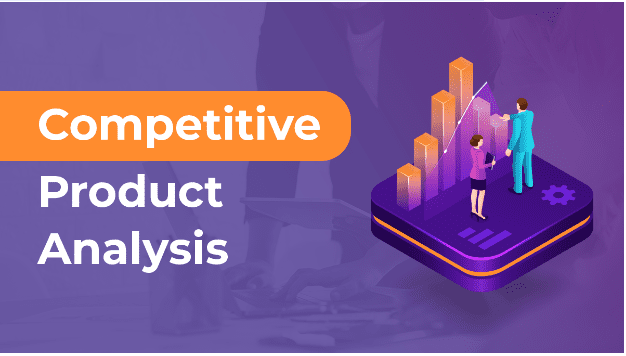
How customers evaluate your product or service against competitors?
When evaluating a SaaS company’s product or service against competitors, customers often consider a range of factors, including:
- Features: Customers evaluate the features and functionality of the product or service and compare them to those offered by competitors.
- Pricing: Customers compare the pricing of the product or service to that of competitors and evaluate the value for money offered by each option.
- User experience: Customers evaluate the user experience of the product or service, including ease of use, navigation, and overall design.
- Support and resources: Customers consider the level of support and resources offered by the SaaS company, such as customer service, user documentation, and training resources.
- Reputation and credibility: Customers consider the reputation and credibility of the SaaS company, including customer reviews and ratings, industry awards, and other forms of social proof.
To help customers evaluate their product or service against competitors, SaaS companies can create detailed comparison charts or provide side-by-side feature comparisons. Additionally, they can provide customer testimonials, case studies, or other forms of social proof that demonstrate the effectiveness and value of their product or service.
Customers evaluate a SaaS company’s product or service against competitors by considering a range of factors, including features, pricing, user experience, support, and reputation. By providing detailed information and social proof, SaaS companies can help customers make informed decisions and choose their products or service over competitors.
Purchase
In the purchase stage, a potential customer becomes a paying customer by purchasing a SaaS company’s product or service. This is a critical stage in the customer journey, as it represents the point where the customer has decided that the product or service meets their needs and offers value for money.
- SaaS companies must provide a seamless and enjoyable customer experience to ensure a successful purchase stage. This can be achieved by offering a clear and easy-to-understand purchasing process, providing multiple payment options, and ensuring the product or service is delivered promptly.
- During the purchase stage, it’s also essential for SaaS companies to provide adequate support and resources to customers. This can include onboarding materials, training resources, and customer support channels that are easily accessible and responsive to customer needs.
- Finally, SaaS companies can use the purchase stage to gather customer feedback and customer data. This can be achieved through post-purchase surveys, customer reviews, or other customer feedback forms. This information can then improve the customer experience and drive future business growth.
The purchase stage is critical in the customer journey, representing the point where a potential customer becomes a paying customer. SaaS companies can increase customer satisfaction and build long-term relationships with their customers by providing a seamless and enjoyable customer experience and offering adequate support and resources.
The stage of purchase in the customer journey
The customer journey’s purchase stage is when a potential customer becomes a paying customer by purchasing a SaaS company’s product or service. This is a critical stage in the customer journey, as it represents the point where the customer has decided that the product or service meets their needs and offers value for money.
- SaaS companies must provide a seamless and enjoyable customer experience to ensure a successful purchase stage. This can be achieved by offering a clear and easy-to-understand purchasing process, providing multiple payment options, and ensuring the product or service is delivered promptly.
- During the purchase stage, it’s also essential for SaaS companies to provide adequate support and resources to customers. This can include onboarding materials, training resources, and customer support channels that are easily accessible and responsive to customer needs.
- Finally, SaaS companies can use the purchase stage to gather customer feedback and customer data. This can be achieved through post-purchase surveys, customer reviews, or other customer feedback forms. This information can then improve the customer experience and drive future business growth.
The purchase stage is critical in the customer journey, representing the point where a potential customer becomes a paying customer. SaaS companies can increase customer satisfaction and build long-term relationships with their customers by providing a seamless and enjoyable customer experience and offering adequate support and resources.
Identifying how customers decide to purchase your product or service
Customers purchase a SaaS company’s product or service based on several factors. Here are some of the critical factors that influence their decision:
- Need: Customers first must identify a need or problem they want to solve. This could be a business challenge, a pain point, or a desire for a specific outcome.
- Research: Once customers have identified a need, they research potential solutions. They may search online, ask for recommendations, or read reviews and case studies to evaluate their options.
- Evaluation: After researching, customers evaluate potential solutions based on various factors, such as features, pricing, user experience, and support.
- Trial: Customers may choose to try out a product or service through a free trial or demo to evaluate its effectiveness and value before purchasing.
- Purchase: Customers decide if the product or service meets their needs and offers value for money.
To help customers decide to purchase their product or service, SaaS companies need to provide comprehensive and accurate information about their product or service, including features, pricing, user experience, and support. They may also offer free trials or demos, customer testimonials, or other forms of social proof demonstrating their product’s or service’s value and effectiveness.
Understanding how customers purchase a SaaS company’s product or service is essential for developing effective marketing and sales strategies that address their needs and concerns and ultimately lead to successful conversions.
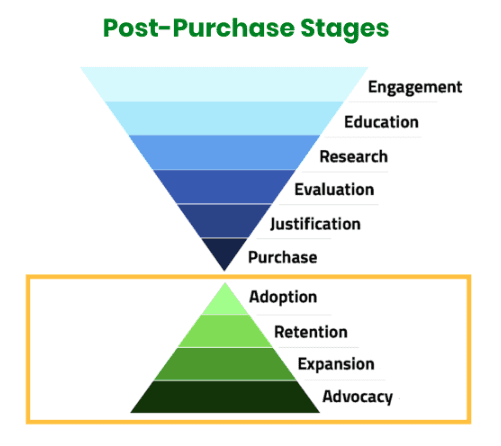
Post-Purchase
A SaaS company’s relationship with the customer begins in the post-purchase stage. This stage is critical in the customer journey. It determines whether the customer will remain loyal and continue to use the product or service or if they will disengage and look for other options.
- To ensure a successful post-purchase stage, SaaS companies must provide ongoing support and resources to their customers. This can include providing regular product updates, offering customer support channels, and creating a community of users where customers can share their experiences and best practices.
- In addition to providing ongoing support, SaaS companies can use the post-purchase stage to gather customer feedback and data. This can be achieved through post-purchase surveys, customer reviews, or other customer feedback forms. This information can then be used to improve the product or service and to develop targeted marketing and sales strategies that address customer needs and concerns.
- Finally, the post-purchase stage allows SaaS companies to upsell or cross-sell additional products or services to their customers. By understanding their customers’ needs and preferences, SaaS companies can identify opportunities to offer complementary products or services to help customers achieve their goals and drive additional revenue.
The post-purchase stage is critical in the customer journey, as it represents the beginning of a long-term relationship between the SaaS company and the customer. SaaS companies can build customer loyalty and drive long-term business success by providing ongoing support and resources, gathering feedback and data, and identifying opportunities for upselling and cross-selling.
Defining the post-purchase stage in the customer journey
The post-purchase stage in the customer journey refers to the set after a customer has purchased a SaaS company’s product or service. During this stage, the SaaS company’s relationship with the customer begins, and it is the company’s responsibility to ensure that the customer is satisfied with their purchase and continues to use the product or service.
- To ensure a successful post-purchase stage, SaaS companies must provide ongoing support and resources to their customers. This can include providing regular product updates, offering customer support channels, and creating a community of users where customers can share their experiences and best practices.
- In addition to providing ongoing support, SaaS companies can use the post-purchase stage to gather customer feedback and data. This can be achieved through post-purchase surveys, customer reviews, or other customer feedback forms. This information can then be used to improve the product or service and to develop targeted marketing and sales strategies that address customer needs and concerns.
- Finally, the post-purchase stage allows SaaS companies to upsell or cross-sell additional products or services to their customers. By understanding their customers’ needs and preferences, SaaS companies can identify opportunities to offer complementary products or services to help customers achieve their goals and drive additional revenue.
The post-purchase stage is critical in the customer journey, as it represents the beginning of a long-term relationship between the SaaS company and the customer. SaaS companies can build customer loyalty and drive long-term business success by providing ongoing support and resources, gathering feedback and data, and identifying opportunities for upselling and cross-selling.
How customers interact with your product or service after the purchase?
After purchasing a SaaS company’s product or service, customers typically interact with it in a variety of ways, including:
- Onboarding: Customers typically go through an onboarding process that helps them get started with the product or service. This may include setting up their account, configuring their settings, and learning how to use the product or service.
- Usage: Once onboarded, customers will begin using the product or service to accomplish their goals. Depending on their needs and preferences, they may use it daily, weekly, or monthly.
- Support: Customers may interact with the company’s customer support team if they have questions or run into issues while using the product or service. This may include using support channels like email, phone, or chat.
- Feedback: Customers may provide feedback to the SaaS company about their experience using the product or service. The company can use this feedback to improve the product or service and develop targeted marketing and sales strategies.
- Upgrades: Over time, customers may need to upgrade to a higher service tier or purchase additional features or modules to meet their changing needs. SaaS companies can use this opportunity to upsell or cross-sell other products or services to their customers.
The post-purchase stage is an essential phase in the customer journey, as it represents an ongoing relationship between the SaaS company and the customer. SaaS companies can build customer loyalty and drive long-term business success by providing ongoing support and resources, gathering feedback, and identifying opportunities for upselling and cross-selling.
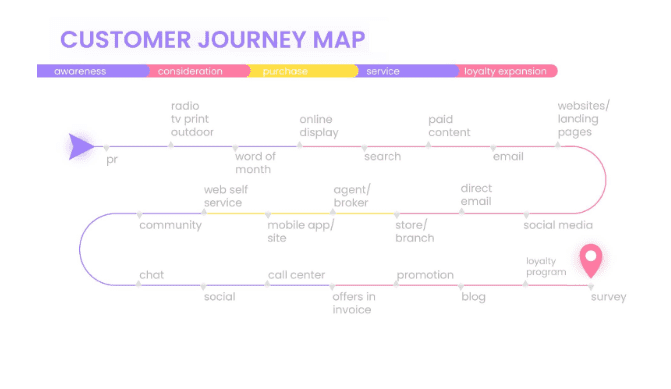
Mapping the Customer Journey
Mapping the customer journey is a process of visualizing and understanding the different stages a customer goes through when interacting with a SaaS company’s product or service. It involves identifying a customer’s various touchpoints and interactions with the company, from initial awareness to post-purchase usage and support.
The customer journey typically involves the following stages:
- Awareness: This is the stage where potential customers become aware of the SaaS company’s product or service. They may learn about it through advertising, word of mouth, or online research.
- Consideration: During this stage, potential customers evaluate the SaaS company’s product or service against competitors and consider whether it meets their needs.
- Purchase: This is when a potential customer becomes a paying customer by purchasing the product or service.
- Post-purchase: After purchasing the product or service, customers interact with it and the company through usage, support, and feedback.
SaaS companies can use various tools and techniques to map the customer journey, such as customer surveys, user testing, and analytics. This can help them gain a deeper understanding of the customer experience and identify areas for improvement and opportunities for growth.
By mapping the customer journey, SaaS companies can gain insights into the different touchpoints and interactions that customers have with their products or service. This information can then be used to develop targeted marketing and sales strategies, improve the product or service, and build stronger customer relationships.
Collecting Data
Collecting data is the first step in mapping the customer journey for a SaaS company. It involves gathering information about how customers interact with the company’s product or service and identifying their touchpoints and interactions at each journey stage.
There are several methods that SaaS companies can use to collect data about the customer journey, including:
- Customer surveys: Surveys can gather customer feedback about their experience with the product or service. This helps identify pain points, areas for improvement, and growth opportunities.
- User testing: User testing involves observing how customers interact with the product or service in a controlled environment. This can provide valuable insights into how customers use the product or service and identify areas for improvement.
- Analytics: Analytics can track customer behavior and interactions with the product or service. This can provide insights into how customers move through the different stages of the journey and help to identify areas where customers drop off or disengage.
- Customer support interactions: Customer support interactions can provide valuable insights into the types of issues and questions customers have at each stage of the journey.
By collecting data about the customer journey, SaaS companies can gain a deeper understanding of how customers interact with their products or service. This information can then be used to develop targeted marketing and sales strategies, improve the product or service, and build stronger customer relationships.
Gathering data on customer behavior and interactions
Gathering customer behavior and interaction data is a critical component of mapping the customer journey for a SaaS company. This data can provide valuable insights into how customers use the product or service, their challenges, and how they interact with the company at each journey stage.
Here are some standard methods that SaaS companies use to gather data on customer behavior and interactions:
- Analytics: Analytics tools can provide detailed information about customer behavior, such as how they navigate the product or service, how long they spend on each page, and which features they use most frequently. This data can be used to identify improvement areas and optimize the user experience.
- Customer feedback: SaaS companies can gather customer feedback through surveys, feedback forms, and user testing. This feedback can provide valuable insights into customer needs, preferences, and pain points.
- Customer support interactions: Customer support interactions can provide insights into the types of issues that customers face when using the product or service. SaaS companies can proactively identify and address common issues by tracking and analyzing customer support interactions.
- Social media monitoring: Social media monitoring tools can be used to track customer sentiment and feedback on social media platforms. This can provide valuable insights into customer perceptions and opinions about the product or service.
By gathering data on customer behavior and interactions, SaaS companies can gain a deeper understanding of the customer journey and use this information to develop targeted marketing and sales strategies, improve the product or service, and build stronger customer relationships.
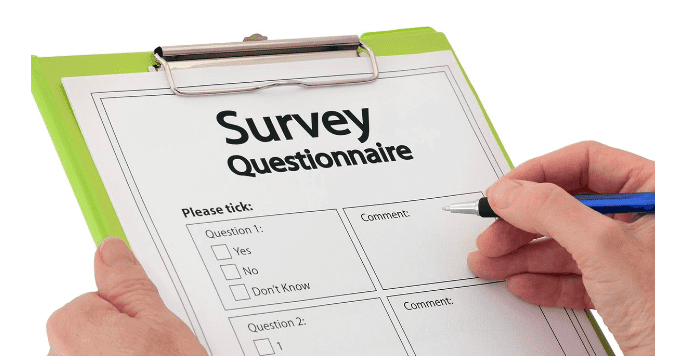
Conducting surveys and interviews to gather customer feedback
Conducting surveys and interviews is a standard method that SaaS companies use to gather customer feedback and insights about their product or service. Surveys and interviews can help companies identify customer needs, preferences, pain points, and opportunities for improvement.
Here are some key considerations when conducting surveys and interviews to gather customer feedback:
- Determine the purpose: SaaS companies should determine the purpose of the survey or interview and what specific information they want to gather from customers. This will help ensure the survey or interview questions are relevant and practical.
- Keep it simple: Surveys and interviews should be easy for customers to complete and take up little time. It’s important to avoid asking too many questions or questions that are too complex or difficult to answer.
- Use open-ended questions: Open-ended questions can provide more detailed and nuanced customer feedback. They can also help to identify specific pain points or issues that customers are experiencing.
- Offer incentives: To encourage customers to participate in surveys or interviews, SaaS companies can offer discounts, free trials, or gift cards.
- Analyze the data: After collecting survey and interview data, SaaS companies should analyze the data to identify trends, themes, and patterns. This information can be used to develop targeted marketing and sales strategies, improve the product or service, and build stronger customer relationships.
Surveys and interviews can be valuable tools for gathering customer feedback and insights. By listening to customer feedback and incorporating it into their business strategy, SaaS companies can improve the customer experience, drive business growth, and build long-term customer relationships.
Creating a Journey Map
Creating a journey map visually represents the customer journey for a SaaS company’s product or service. A journey map can help SaaS companies understand the different stages of the customer journey, identify customer pain points and opportunities for improvement, and develop targeted marketing and sales strategies.
Here are some steps that SaaS companies can take to create a journey map:
- Define the journey stages: The first step is to define the scenes of the customer journey for the product or service. This typically includes awareness, consideration, purchase, and post-purchase locations.
- Identify touchpoints and interactions: Next, SaaS companies should identify customers’ touchpoints and interactions at each stage of the journey. This can include website visits, email communications, customer support interactions, and product usage.
- Map the customer experience: Once touchpoints and interactions have been identified, SaaS companies can map the customer experience by visualizing the journey. This can be done using various tools, such as journey mapping software or whiteboard sketches.
- Add customer feedback and insights: SaaS companies can add customer feedback and insights to the journey map to provide a complete picture of the customer experience. This can include input from surveys, interviews, and analytics.
- Analyze and use the journey map: Once the journey map is complete, SaaS companies should analyze it to identify pain points and opportunities for improvement. This information can be used to develop targeted marketing and sales strategies, improve the product or service, and build stronger customer relationships.
Creating a journey map can help SaaS companies gain a deeper understanding of the customer journey and identify areas for improvement. Using customer feedback and insights to inform the journey map, SaaS companies can develop targeted marketing and sales strategies that address customer needs and concerns and drive long-term business success.
Mapping out the customer journey from awareness to post-purchase
Mapping out the customer journey from awareness to post-purchase involves identifying the different stages customers go through when interacting with a SaaS company’s product or service and the touchpoints and interactions they have at each location.
Here is an overview of the customer journey stages and touchpoints:
- Awareness: This is the stage where potential customers become aware of the SaaS company’s product or service. Touchpoints at this stage include advertising, social media, word of mouth, and online research.
- Consideration: During this stage, potential customers evaluate the SaaS company’s product or service against competitors and consider whether it meets their needs. Touchpoints at this stage include website visits, product demos, and customer reviews.
- Purchase: This is when a potential customer becomes a paying customer by purchasing the product or service. Touchpoints at this stage include checkout and payment processes.
- Onboarding: After purchasing the product or service, customers go through an onboarding process that helps them get started with the product or service. Touchpoints at this stage include account setup, product configuration, and initial usage.
- Usage: Once onboarded, customers begin using the product or service to accomplish their goals. Touchpoints at this stage include ongoing product usage, support interactions, and feedback and reviews.
- Upgrades: Over time, customers may need to upgrade to a higher service tier or purchase additional features or modules to meet their changing needs. Touchpoints at this stage include upsell and cross-sell opportunities and targeted marketing and sales campaigns.
- Renewal: At the end of the subscription period, customers can renew their subscriptions or cancel. Touchpoints at this stage include renewal reminders, incentives, and retention campaigns.
- Post-purchase: After purchasing the product or service, customers interact with it and the company through usage, support, and feedback. Touchpoints at this stage include ongoing support and resources, product updates and improvements, and community engagement.
By mapping the customer journey from awareness to post-purchase, SaaS companies can better understand customers’ different touchpoints and interactions with their products or service. This information can then be used to develop targeted marketing and sales strategies, improve the product or service, and build stronger customer relationships.
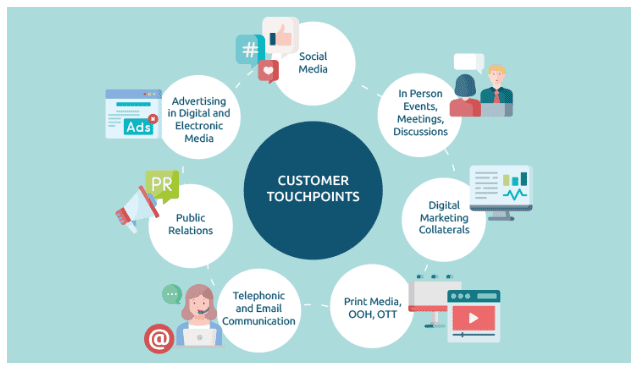
Identifying touchpoints and opportunities for engagement
Identifying touchpoints and opportunities for engagement is an integral part of mapping the customer journey for a SaaS company. By understanding where customers interact with the product or service and the company, SaaS companies can develop targeted marketing and sales strategies, improve the product or service, and build stronger customer relationships.
Here are some ways that SaaS companies can identify touchpoints and opportunities for engagement:
- Analyze customer data: SaaS companies can use customer data to identify where customers are interacting with the product or service and the company. This can include analyzing website traffic, social media engagement, customer support interactions, and product usage data.
- Conduct customer surveys and interviews: Surveys and discussions can help SaaS companies identify touchpoints and opportunities for engagement by asking customers about their experiences and interactions with the product or service and the company.
- Map the customer journey: Mapping the journey can help SaaS companies identify touchpoints and engagement opportunities at each trip stage.
- Monitor social media and review sites: SaaS companies can monitor social media and review sites to identify where customers are talking about the product or service and the company. This can provide insights into customer sentiment and identify areas for improvement.
- Engage with customers: SaaS companies can engage with customers directly through customer support interactions, community forums, and social media. This helps build stronger relationships with customers and identify opportunities for engagement.
Once touchpoints and opportunities for engagement have been identified, SaaS companies can develop targeted marketing and sales strategies, improve the product or service, and build stronger customer relationships. By engaging with customers at the right touchpoints, SaaS companies can increase customer satisfaction, drive business growth, and build long-term customer relationships.
Refining the Journey Map
Refining the journey map is an ongoing process of identifying and addressing areas for improvement in the customer journey for a SaaS company’s product or service. It involves analyzing customer feedback and data, identifying pain points and opportunities for improvement, and making changes to the product or service and marketing and sales strategies.
Here are some steps that SaaS companies can take to refine the journey map:
- Analyze customer feedback and data: SaaS companies should regularly analyze customer feedback and data to identify pain points and areas for improvement in the customer journey. This can include analyzing customer surveys, social media feedback, and product usage data.
- Identify pain points and opportunities for improvement: Once customer feedback and data have been analyzed, SaaS companies should identify pain points and opportunities for improvement in the customer journey. This may involve identifying areas where customers are dropping off, experiencing difficulty, or expressing dissatisfaction.
- Make changes to the product or service: SaaS companies can change the product or service to address pain points and improve the customer experience. This may involve adding new features, improving existing features, or simplifying the user interface.
- Update marketing and sales strategies: SaaS companies can update their marketing and sales strategies to address customer needs and pain points better. This may involve targeting specific customer segments, developing new campaigns, or improving the website and other marketing materials.
- Monitor and analyze the results: After making changes to the product or service and marketing and sales strategies, SaaS companies should monitor and analyze the results to determine if the changes have positively impacted the customer journey. This may involve tracking customer behavior and engagement and analyzing customer feedback.
By regularly refining the journey map, SaaS companies can improve the customer experience, drive business growth, and build long-term customer relationships. By listening to customer feedback and making changes to the product or service and marketing and sales strategies, SaaS companies can address pain points and improve the customer journey at every stage.
Identifying areas of friction or confusion in the customer journey
Identifying areas of friction or confusion in the customer journey is essential in refining the journey map for a SaaS company. Conflict or confusion can occur when customers encounter obstacles or difficulties on the trip, leading to frustration, dissatisfaction, and even abandonment of the product or service.
Here are some ways that SaaS companies can identify areas of friction or confusion in the customer journey:
- Analyze customer support interactions: Customer support interactions can provide valuable insights into areas where customers are experiencing difficulties or confusion. By analyzing support tickets, live chat transcripts, and other support interactions, SaaS companies can identify common issues and pain points.
- Conduct user testing: User testing involves observing how customers interact with the product or service in a controlled environment. This helps identify confusion or difficulty in the user interface or product features.
- Monitor customer feedback: SaaS companies should monitor customer feedback on social media, review sites, and surveys to identify where customers express confusion or dissatisfaction.
- Analyze website analytics: Website analytics can provide insights into where customers are dropping off or encountering difficulties on the website. By analyzing website data, SaaS companies can identify areas where the website or user interface can be improved.
- Map the customer journey: Mapping the customer journey can help SaaS companies identify areas of friction or confusion at each stage. By analyzing the customer journey, SaaS companies can identify areas where customers encounter difficulties or obstacles.
Once areas of friction or confusion have been identified, SaaS companies can take steps to address these issues and improve the customer journey. This may involve improving the user interface, simplifying the product or service, providing additional support or resources, or developing targeted marketing and sales strategies. By addressing friction or confusion, SaaS companies can improve the customer experience, increase customer satisfaction, and drive business growth.
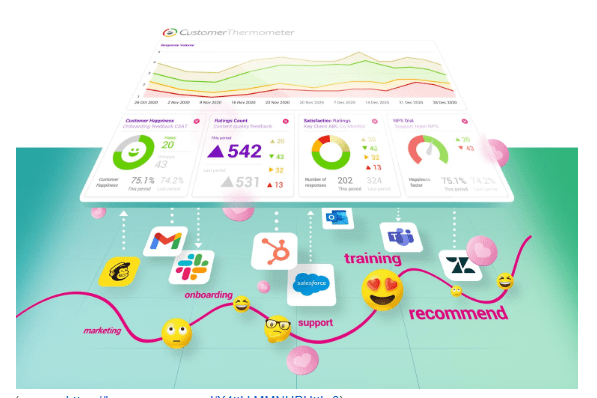
Refining the journey map based on customer feedback and behavior
Refining the journey map based on customer feedback and behavior is essential for SaaS companies to improve the customer experience and drive business growth. By analyzing customer feedback and behavior, SaaS companies can identify pain points, areas of confusion, and opportunities for improvement in the customer journey and make changes to address these issues.
Here are some steps that SaaS companies can take to refine the journey map based on customer feedback and behavior:
- Collect customer feedback: SaaS companies should regularly collect customer feedback through surveys, user testing, and support interactions. This feedback can provide valuable insights into the customer experience and identify pain points and areas for improvement.
- Analyze customer behavior: SaaS companies should also analyze customer behavior and usage data to identify patterns and trends in customer behavior. This data can provide insights into where customers are dropping off, encountering difficulties, or spending the most time.
- Identify pain points and areas for improvement: Based on customer feedback and behavior data, SaaS companies should identify pain points and areas for improvement in the customer journey. This may involve identifying where customers are experiencing difficulties, where they are expressing dissatisfaction, or where they are spending the most time.
- Make changes to the product or service: SaaS companies can change the product or service to address pain points and improve the customer experience. This may involve adding new features, improving existing features, or simplifying the user interface.
- Update marketing and sales strategies: SaaS companies can also update their marketing and sales strategies to address customer needs and pain points better. This may involve targeting specific customer segments, developing new campaigns, or improving the website and other marketing materials.
- Monitor and analyze the results: After making changes to the product or service and marketing and sales strategies, SaaS companies should monitor and analyze the results to determine if the changes have positively impacted the customer journey. This may involve tracking customer behavior and engagement and analyzing customer feedback.
By refining the journey map based on customer feedback and behavior, SaaS companies can improve the customer experience, increase customer satisfaction, and drive business growth. By listening to customer feedback and making changes to the product or service and marketing and sales strategies, SaaS companies can address pain points and improve the customer journey at every stage.
Leveraging the Customer Journey Map
Leveraging the customer journey map is essential for SaaS companies to improve the customer experience and drive business growth. By understanding the different stages of the customer journey and the touchpoints and interactions that customers have at each location, SaaS companies can develop targeted marketing and sales strategies, improve the product or service, and build stronger customer relationships.
Here are some ways that SaaS companies can leverage the customer journey map:
- Develop targeted marketing and sales strategies: The customer journey map can help SaaS companies develop targeted marketing and sales strategies that address customer needs and concerns at each journey stage. SaaS companies can increase customer engagement and drive business growth by developing targeted campaigns and messaging.
- Improve the product or service: The customer journey map can also help SaaS companies identify pain points and areas for improvement in the product or service. By changing the product or service, SaaS companies can improve the customer experience and increase customer satisfaction.
- Provide targeted support and resources: SaaS companies can use the customer journey map to provide targeted support and resources to customers at each journey stage. This may involve giving self-service resources, targeted support interactions, or personalized training and onboarding.
- Build stronger customer relationships: By leveraging the customer journey map, SaaS companies can build stronger relationships by engaging with them at the right touchpoints and addressing their needs and concerns. This can help to increase customer satisfaction, loyalty, and advocacy.
- Monitor and analyze the results: SaaS companies should monitor and analyze the results of their efforts to leverage the customer journey map to determine if they positively impact the customer experience and business growth. This may involve tracking customer behavior and engagement, analyzing customer feedback, and measuring key performance indicators.
Leveraging the customer journey map can help SaaS companies improve the customer experience, drive business growth, and build stronger customer relationships. By understanding the different stages of the customer journey and the touchpoints and interactions customers have at each location, SaaS companies can develop targeted strategies and resources that address customer needs and concerns and drive long-term business success.
Marketing
Marketing is a crucial component of the customer journey for SaaS companies. At the awareness and consideration stages, marketing plays a vital role in attracting potential customers and convincing them to consider the SaaS company’s product or service.
Here are some ways that SaaS companies can leverage marketing to improve the customer journey:
- Develop targeted campaigns: SaaS companies can develop targeted marketing campaigns that address the needs and concerns of potential customers at each stage of the journey. SaaS companies can increase engagement and drive business growth by developing campaigns tailored to the customer journey.
- Use targeted messaging: SaaS companies can use targeted messaging in their marketing materials to address potential customer’s pain points and concerns at each journey stage. This can build trust and credibility with potential customers and increase the chances of conversion.
- Leverage social media: Social media can be a powerful tool for SaaS companies to engage with potential customers and build brand awareness. SaaS companies can increase reach and engagement with potential customers by creating engaging content and leveraging social media advertising.
- Develop customer personas: SaaS companies can develop customer personas to understand better potential customers’ needs and concerns at each journey stage. SaaS companies can develop more effective marketing strategies by understanding potential customers’ motivations and pain points.
- Provide educational resources: SaaS companies can provide educational resources, such as whitepapers, ebooks, and webinars, that help potential customers understand the value of the product or service. By providing valuable educational resources, SaaS companies can build trust and credibility with potential customers and increase the chances of conversion.
By leveraging marketing to improve the customer journey, SaaS companies can increase engagement, drive business growth, and build stronger customer relationships. By developing targeted campaigns and messaging, leveraging social media, and providing educational resources, SaaS companies can attract potential customers and convince them to consider the product or service by developing targeted campaigns and messaging, leveraging social media, and providing educational resources.
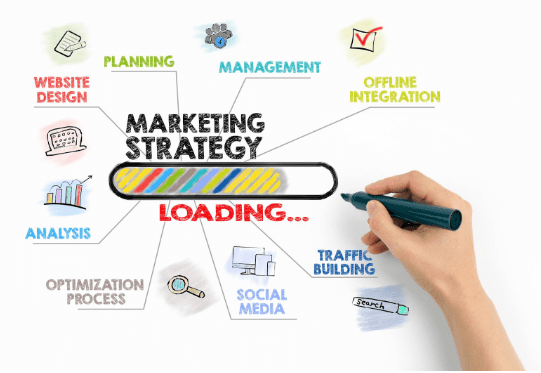
Developing a marketing strategy based on the customer journey
Developing a marketing strategy based on the customer journey is crucial for SaaS companies to attract potential customers and drive business growth. By understanding the different stages of the customer journey and the touchpoints and interactions that customers have at each location, SaaS companies can develop targeted marketing strategies that address the needs and concerns of potential customers.
Here are some steps that SaaS companies can take to develop a marketing strategy based on the customer journey:
- Identify customer personas: SaaS companies should develop customer personas representing potential customers interacting with the product or service. This can help better understand potential customers’ needs and concerns and create targeted messaging and campaigns.
- Map the customer journey: SaaS companies should map the journey to understand customer touchpoints and interactions at each stage. This helps identify areas where marketing can be leveraged to improve the customer experience and drive business growth.
- Develop targeted campaigns: Based on the customer journey map and customer personas, SaaS companies should develop targeted campaigns that address the needs and concerns of potential customers at each stage of the journey. This may involve developing campaigns focusing on awareness, consideration, or conversion.
- Use targeted messaging: SaaS companies should use targeted messaging in their marketing materials to address potential customer’s pain points and concerns at each journey stage. This can build trust and credibility with potential customers and increase the chances of conversion.
- Leverage social media: Social media can be a powerful tool for SaaS companies to engage with potential customers and build brand awareness. SaaS companies can increase reach and engagement with potential customers by creating engaging content and leveraging social media advertising.
- Measure results: SaaS companies should measure the results of their marketing efforts to determine if they positively impact the customer journey and business growth. This may involve tracking customer behavior and engagement, analyzing customer feedback, and measuring key performance indicators.
SaaS companies can attract potential customers, increase engagement, and drive business growth by developing a marketing strategy based on the customer journey. By identifying customer personas, mapping the customer journey, developing targeted campaigns and messaging, leveraging social media, and measuring results, SaaS companies can create a comprehensive marketing strategy that addresses the needs and concerns of potential customers at each stage of the journey.
Creating targeted campaigns and messaging for each stage of the journey
Creating targeted campaigns and messaging for each customer journey stage is crucial for SaaS companies to engage potential customers and drive business growth. By developing campaigns and messaging tailored to potential customers’ needs and concerns at each journey stage, SaaS companies can increase engagement and improve the customer experience.
Here are some ways that SaaS companies can create targeted campaigns and messages for each stage of the customer journey:
- Awareness stage: At the awareness stage, SaaS companies should focus on building brand awareness and creating interest in the product or service. This may involve developing educational resources, such as blog posts or webinars, that provide value to potential customers and showcase the product’s or service’s benefits.
- Consideration stage: At the consideration stage, SaaS companies should focus on building trust and credibility with potential customers and convincing them to consider the product or service. This may involve developing case studies or customer testimonials demonstrating the product or service’s value and addressing common concerns.
- Purchase stage: At the purchase stage, SaaS companies should focus on providing a seamless and convenient buying experience for potential customers. This may involve developing a user-friendly checkout process and providing clear and transparent pricing information.
- Post-purchase stage: At the post-purchase stage, SaaS companies should focus on building long-term relationships with customers and ensuring their satisfaction with the product or service. This may involve providing onboarding resources, such as tutorials or training sessions, and offering ongoing support and resources to customers.
By creating targeted campaigns and messaging for each customer journey stage, SaaS companies can improve the customer experience, increase engagement, and drive business growth. SaaS companies can build trust and credibility, increase conversions, and build long-term customer relationships by focusing on potential customers’ specific needs and concerns at each journey stage.
Sales
Sale is a critical component of the customer journey for SaaS companies. At the consideration and purchase stages, sales are vital in converting potential customers into paying customers.
Here are some ways that SaaS companies can leverage sales to improve the customer journey:
- Develop a sales process: SaaS companies should develop a sales process tailored to the customer journey and addresses the needs and concerns of potential customers at each stage. This may involve creating a lead scoring system or a sales funnel that guides potential customers through the buying process.
- Provide targeted sales support: SaaS companies should provide targeted sales support to potential customers at each journey stage. This may involve providing resources, such as product demos or case studies, to help potential customers understand the product or service’s value.
- Use targeted messaging: SaaS companies should use targeted messaging in their sales materials to address potential customers’ pain points and concerns at each journey stage. This can build trust and credibility with potential customers and increase the chances of conversion.
- Develop sales enablement tools: SaaS companies can develop sales enablement tools, such as sales decks or objection handling guides, that help sales teams address the needs and concerns of potential customers at each stage of the journey.
- Measure results: SaaS companies should measure the results of their sales efforts to determine if they positively impact the customer journey and business growth. This may involve tracking conversion rates, analyzing sales data, and measuring key performance indicators.
By leveraging sales to improve the customer journey, SaaS companies can increase engagement, drive business growth, and build stronger customer relationships. By developing a tailored sales process, providing targeted sales support and messaging, developing sales enablement tools, and measuring results, SaaS companies can convert potential customers into paying customers and build long-term relationships.
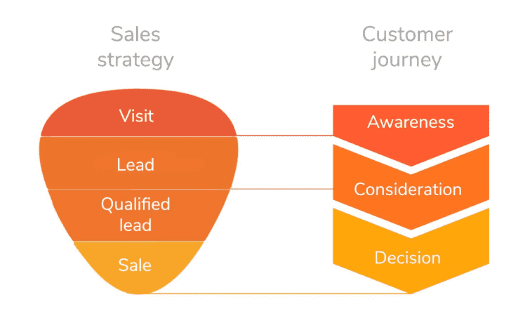
Developing a sales strategy based on the customer journey
Developing a sales strategy based on the customer journey is essential for SaaS companies to improve the customer experience and drive business growth.
By understanding the different stages of the customer journey and the touchpoints and interactions that customers have at each location, SaaS companies can develop a sales strategy that addresses the needs and concerns of potential customers and increases the chances of conversion.
Here are some steps that SaaS companies can take to develop a sales strategy based on the customer journey:
- Identify customer personas: SaaS companies should develop customer personas representing potential customers interacting with the product or service. This can help better understand potential customers’ needs and concerns and develop targeted sales strategies.
- Map the customer journey: SaaS companies should map the journey to understand customer touchpoints and interactions at each stage. This helps identify areas where sales can be leveraged to improve the customer experience and drive business growth.
- Develop a tailored sales process: Based on the customer journey map and customer personas, SaaS companies should develop a tailored sales process that addresses the needs and concerns of potential customers at each stage of the journey. This may involve creating a lead scoring system or a sales funnel that guides potential customers through the buying process.
- Provide targeted sales support: SaaS companies should provide targeted sales support to potential customers at each journey stage. This may involve providing resources, such as product demos or case studies, to help potential customers understand the product or service’s value.
- Use targeted messaging: SaaS companies should use targeted messaging in their sales materials to address potential customers’ pain points and concerns at each journey stage. This can build trust and credibility with potential customers and increase the chances of conversion.
- Develop sales enablement tools: SaaS companies can develop sales enablement tools, such as sales decks or objection handling guides, that help sales teams address the needs and concerns of potential customers at each stage of the journey.
- Measure results: SaaS companies should measure the results of their sales efforts to determine if they positively impact the customer journey and business growth. This may involve tracking conversion rates, analyzing sales data, and measuring key performance indicators.
By developing a sales strategy based on the customer journey, SaaS companies can improve the customer experience, increase engagement, and drive business growth. By identifying customer personas, mapping the customer journey, developing a tailored sales process, providing targeted sales support and messaging, developing sales enablement tools, and measuring results, SaaS companies can create a comprehensive sales strategy that addresses the needs and concerns of potential customers at each stage of the journey.
Providing personalized and relevant information to customers at each stage of the journey
Providing personalized and relevant information to customers at each customer journey stage is crucial for SaaS companies to improve the customer experience and increase engagement.
By understanding customers’ specific needs and concerns at each stage of the journey, SaaS companies can provide targeted information and resources that address those needs and concerns, increasing the chances of conversion and building long-term relationships with customers.
Here are some ways that SaaS companies can provide personalized and relevant information to customers at each stage of the customer journey:
- Awareness stage: At the awareness stage, SaaS companies can provide educational resources, such as blog posts, ebooks, and webinars, that give value to potential customers and showcase the benefits of the product or service. The content should be tailored to the interests and needs of the potential customer and delivered through the channels the customer is most likely to use.
- Consideration stage: At the consideration stage, SaaS companies can provide case studies, customer testimonials, and other resources that demonstrate the value of the product or service and address common concerns. These resources should be personalized to the specific needs and concerns of the potential customer. They should be delivered through the channels that the customer is most likely to use.
- Purchase stage: At the purchase stage, SaaS companies can provide information on pricing, features, and other essential details to the potential customer. This information should be clear, transparent, and easy to access. It should be provided through the channels that the customer is most likely to use.
- Post-purchase stage: At the post-purchase stage, SaaS companies can provide onboarding resources, such as tutorials or training sessions, that help customers get started with the product or service. They can also provide ongoing support and resources that help customers get the most out of the product or service, increasing customer satisfaction and reducing churn.
By providing personalized and relevant information to customers at each customer journey stage, SaaS companies can improve the customer experience, increase engagement, and drive business growth. By tailoring the knowledge and resources to the specific needs and concerns of the customer and by delivering them through the channels that the customer is most likely to use, SaaS companies can build trust and credibility, increase conversions, and build long-term relationships with customers.
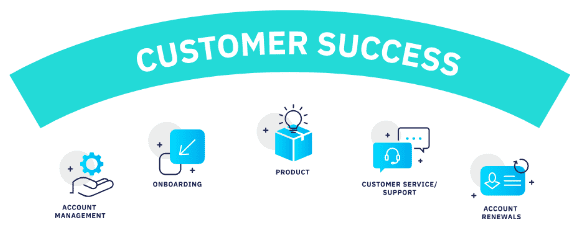
Customer Success
Customer success is a critical component of the customer journey for SaaS companies. It involves ensuring that customers achieve their desired outcomes with the product or service and are satisfied with their experience. SaaS companies can increase customer retention, reduce churn, and drive business growth by focusing on customer success.
Here are some ways that SaaS companies can leverage customer success to improve the customer journey:
- Develop a customer success strategy: SaaS companies should develop a customer success strategy tailored to the customer journey and addresses the needs and concerns of customers at each stage. This may involve creating a customer success plan that outlines the goals and objectives of each customer.
- Provide onboarding and training: SaaS companies should provide onboarding and training resources that help customers get started with the product or service and understand how to use it effectively. This can help to reduce confusion and frustration and increase customer satisfaction.
- Provide ongoing support: SaaS companies should provide ongoing support and resources to customers to help them get the most out of the product or service. This may involve providing a help center, FAQs, or chat support and promptly and effectively addressing customer inquiries.
- Collect and analyze customer feedback: SaaS companies should collect and analyze customer feedback to identify areas where improvements can be made to the product or service and to understand customers’ specific needs and concerns. This feedback can inform product development and improve the customer experience.
- Measure results: SaaS companies should measure the results of their customer success efforts to determine if they positively impact the customer journey and business growth. This may involve tracking customer satisfaction, retention rates, and other key performance indicators.
By leveraging customer success to improve the customer journey, SaaS companies can increase customer retention, reduce churn, and drive business growth. By developing a customer success strategy, onboarding and training, ongoing support, collecting and analyzing customer feedback, and measuring results, SaaS companies can build long-term relationships with customers and ensure they achieve their desired outcomes with the product or service.
Developing a customer success strategy based on the customer journey
Developing a customer success strategy based on the customer journey is crucial for SaaS companies to improve the customer experience and increase engagement.
By understanding the different stages of the customer journey and the touchpoints and interactions that customers have at each location, SaaS companies can develop a customer success strategy that addresses the needs and concerns of customers and increases the chances of retention and expansion.
Here are some steps that SaaS companies can take to develop a customer success strategy based on the customer journey:
- Identify customer personas: SaaS companies should develop customer personas representing the different types of customers interacting with the product or service. This can help better understand customers’ needs and concerns and develop targeted customer success strategies.
- Map the customer journey: SaaS companies should map the journey to understand customer touchpoints and interactions at each stage. This helps identify areas where customer success can be leveraged to improve the customer experience and drive business growth.
- Develop a tailored customer success plan: Based on the customer journey map and customer personas, SaaS companies should develop a customized customer success plan that addresses the needs and concerns of customers at each stage of the journey. This may involve creating a set of goals and objectives for each customer and a plan to achieve those goals.
- Provide onboarding and training: SaaS companies should provide onboarding and training resources that help customers get started with the product or service and understand how to use it effectively. This can help to reduce confusion and frustration and increase customer satisfaction.
- Provide ongoing support: SaaS companies should provide ongoing support and resources to customers to help them get the most out of the product or service. This may involve providing a help center, FAQs, or chat support and promptly and effectively addressing customer inquiries.
- Collect and analyze customer feedback: SaaS companies should collect and analyze customer feedback to identify areas where improvements can be made to the product or service and to understand customers’ specific needs and concerns. This feedback can inform product development and improve the customer experience.
- Measure results: SaaS companies should measure the results of their customer success efforts to determine if they positively impact the customer journey and business growth. This may involve tracking customer satisfaction, retention rates, and other key performance indicators.
By developing a customer success strategy based on the customer journey, SaaS companies can improve the customer experience, increase engagement, and drive business growth.
By identifying customer personas, mapping the customer journey, developing a tailored customer success plan, providing onboarding and training, providing ongoing support and resources, collecting and analyzing customer feedback, and measuring results, SaaS companies can develop a comprehensive customer success strategy that addresses the needs and concerns of customers at each stage of the journey.
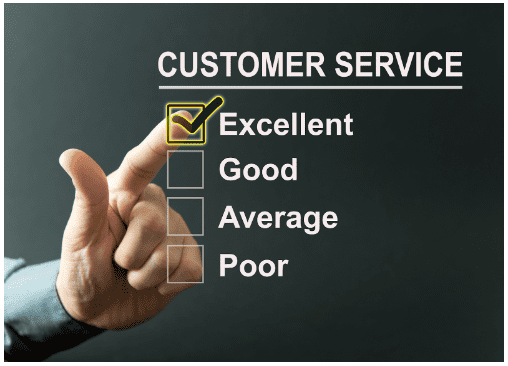
Providing exceptional customer support and onboarding
Providing exceptional customer support and onboarding is crucial for SaaS companies to improve the customer experience and increase engagement. SaaS companies can increase customer satisfaction, reduce churn, and drive business growth by ensuring customers have access to the resources and support needed to use the product or service effectively.
Here are some ways that SaaS companies can provide exceptional customer support and onboarding:
- Develop a comprehensive onboarding process: SaaS companies should develop a thorough onboarding process that guides customers through the product or service and ensures they have the knowledge and resources they need to use it effectively. This may involve providing a step-by-step guide, video tutorials, or live training sessions.
- Provide multiple channels for support: SaaS companies should provide various channels for customers to access support, such as email, phone, chat, or a help center. This ensures that customers get the help they need when needed and through the most convenient channel.
- Offer personalized support: SaaS companies should offer customized support tailored to customers’ needs and concerns. This may involve assigning a dedicated customer success manager or support representative or providing targeted resources that address the customer’s needs.
- Ensure timely and effective responses: SaaS companies should address customer inquiries promptly and effectively. This can help build customer trust and credibility and increase customer satisfaction.
- Collect and analyze customer feedback: SaaS companies should collect and analyze customer feedback to identify areas where improvements can be made to the support and onboarding process. This feedback can inform product development and improve the customer experience.
By providing exceptional customer support and onboarding, SaaS companies can improve the customer experience, increase engagement, and drive business growth.
By developing a comprehensive onboarding process, providing multiple channels for support, offering personalized support, ensuring timely and effective responses, and collecting and analyzing customer feedback, SaaS companies can build long-term relationships with customers and ensure that they achieve their desired outcomes with the product or service.
Product Development
Product development is a critical component of the customer journey for SaaS companies. By developing a product that meets the needs and expectations of customers, SaaS companies can increase customer satisfaction, retention, and business growth.
Here are some ways that SaaS companies can leverage the customer journey to inform product development:
- Gather customer feedback: SaaS companies should gather customer feedback at every stage of the customer journey to understand customers’ needs, concerns, and expectations. This feedback can be collected through surveys, interviews, and other feedback channels.
- Analyze customer behavior: SaaS companies should analyze customer behavior at every stage of the customer journey to understand how customers use the product or service, where they are encountering friction or confusion, and where there are opportunities for improvement. This analysis can be conducted through data analysis, user testing, and other methods.
- Develop a customer-centric product roadmap: Based on customer feedback and behavior analysis, and SaaS companies should develop a customer-centric product roadmap that prioritizes the features, functionality, and improvements that are most important to customers. This roadmap should be updated regularly based on new feedback and analysis.
- Test and iterate: SaaS companies should test new features and functionality with customers to ensure that they meet their needs and expectations. This testing should be conducted through user testing, beta testing, and other methods and should be used to inform iterative improvements to the product.
- Monitor and measure success: SaaS companies should monitor and measure the success of new features and functionality to determine if they positively impact the customer journey and business growth. This may involve tracking customer satisfaction, retention rates, and other key performance indicators.
By leveraging the customer journey to inform product development, SaaS companies can improve the customer experience, increase engagement, and drive business growth. By gathering customer feedback, analyzing customer behavior, developing a customer-centric product roadmap, testing and iterating, and monitoring and measuring success, SaaS companies can build a product that meets customers’ needs and expectations and drives long-term relationships and business growth.
Using the customer journey map to inform product development decisions.
Using the customer journey map to inform product development decisions is a powerful way for SaaS companies to ensure that they are building a product that meets the needs and expectations of customers.
SaaS companies can develop a product roadmap that addresses customers’ specific needs and concerns by understanding the different stages of the customer journey and the touchpoints and interactions that customers have at each stage.
Here are some ways that SaaS companies can use the customer journey map to inform product development decisions:
- Identify customer pain points: By analyzing the customer journey map, SaaS companies can identify the pain points and areas of friction that customers experience at each journey stage. This information can inform product development decisions and prioritize features and improvements that address these pain points.
- Understand customer needs and expectations: The journey map can provide insights into the needs and expectations of customers at each stage of the journey. By understanding these needs and expectations, SaaS companies can build a product that meets customers’ specific needs and delivers a superior customer experience.
- Prioritize features and functionality: The customer journey map can help SaaS companies prioritize features and functionality that are most important to customers at each stage of the journey. By developing a product roadmap focused on these priorities, SaaS companies can ensure that they are building a product that meets customers’ needs and drives business growth.
- Test and iterate: The customer journey map can inform testing and iterative development of the product. By testing new features and functionality with customers and incorporating feedback into the development process, SaaS companies can ensure that the product meets customers’ needs and expectations by testing new features and functionality and incorporating feedback into the development process.
- Monitor and measure success: The customer journey map can also inform the monitoring and measurement of the success of the product. By tracking customer satisfaction, retention rates, and other key performance indicators, SaaS companies can ensure that the product delivers value to customers and drives business growth.
By using the customer journey map to inform product development decisions, SaaS companies can build a product that meets customers’ needs and expectations and delivers a superior customer experience.
By identifying customer pain points, understanding customer needs and expectations, prioritizing features and functionality, testing and iterating, and monitoring and measuring success, SaaS companies can ensure that they are building a product that drives long-term relationships and business growth.
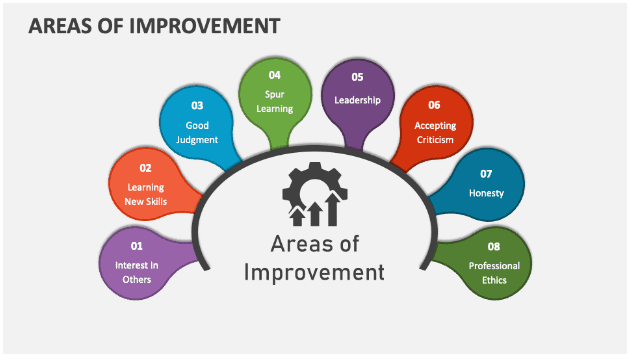
Identifying areas for improvement and innovation based on customer feedback
Identifying areas for improvement and innovation based on customer feedback is a critical component of product development for SaaS companies. By gathering customer feedback at every stage of the customer journey, SaaS companies can identify areas where improvements can be made to the product or service, and innovation can drive business growth.
Here are some ways that SaaS companies can identify areas for improvement and innovation based on customer feedback:
- Collect customer feedback: SaaS companies should collect customer feedback at every stage of the customer journey to understand customers’ needs, concerns, and expectations. This feedback can be managed through surveys, interviews, and other channels.
- Analyze customer feedback: SaaS companies should analyze customer feedback to identify areas where improvements can be made to the product or service. This analysis can be conducted through data analysis, sentiment analysis, and other methods.
- Prioritize improvements: SaaS companies should prioritize improvements based on customer feedback and their impact on the customer experience and business growth. This may involve developing a product roadmap that prioritizes the most significant improvements.
- Innovate based on customer feedback: SaaS companies should use customer feedback as a source of innovation to drive business growth. This may involve developing new features, functionality, or products that address customers’ specific needs and concerns.
- Test and iterate: SaaS companies should test new improvements and innovations with customers to meet their needs and expectations. This testing should be conducted through user testing, beta testing, and other methods and should be used to inform iterative improvements to the product.
- Monitor and measure success: SaaS companies should monitor and measure the success of improvements and innovations to determine if they positively impact the customer journey and business growth. This may involve tracking customer satisfaction, retention rates, and other key performance indicators.
By identifying areas for improvement and innovation based on customer feedback, SaaS companies can build a product that meets customers’ needs and expectations and drives long-term relationships and business growth. By collecting customer feedback, analyzing feedback, prioritizing improvements, innovating based on feedback, testing and iterating, and monitoring and measuring success, SaaS companies can continuously improve the product or service and deliver a superior customer experience.
Conclusion
Final thoughts and recommendations
In conclusion, mapping the customer journey is critical for SaaS companies looking to improve the customer experience, increase engagement, and drive business growth. By understanding the different stages of the journey and the touchpoints and interactions that customers have at each stage, SaaS companies can develop a comprehensive strategy that meets the needs and expectations of customers.
To leverage the customer journey effectively, SaaS companies should collect customer feedback, analyze customer behavior, develop a customer-centric product roadmap, provide personalized support, and monitor and measure success.
These strategies should be used to inform marketing, sales, customer success, and product development decisions, ensuring that the customer journey remains at the center of the company’s strategy.
Some recommendations for SaaS companies looking to leverage the customer journey include the following:
- Develop a customer-centric culture: SaaS companies should develop a culture that prioritizes the customer and is focused on delivering a superior customer experience.
- Use data to inform decisions: SaaS companies should use data to inform decisions and measure the impact of their strategies on the customer journey.
- Continuously improve: SaaS companies should constantly improve the customer experience by gathering feedback, analyzing behavior, and innovating based on customer needs and expectations.
By following these recommendations and leveraging the customer journey effectively, SaaS companies can build long-term customer relationships and drive business growth.

FAQs
What is customer journey mapping for SaaS companies?
Customer journey mapping for SaaS companies is the process of identifying and analyzing the stages and touchpoints that customers go through as they interact with a SaaS product or service, from initial awareness through post-purchase support.
The goal of customer journey mapping is to gain a deep understanding of the customer experience and to identify areas where improvements can be made to enhance the customer journey and increase engagement and retention.
Customer journey mapping typically involves collecting and analyzing data on customer behavior, feedback, and interactions at each stage of the journey. This data is used to create a visual representation of the customer journey, which can be used to identify pain points, opportunities for engagement, and areas where improvements can be made to enhance the customer experience.
By mapping the customer journey, SaaS companies can develop a comprehensive strategy that meets the needs and expectations of customers at each stage of the trip, from initial awareness through post-purchase support. This can help to increase customer satisfaction, reduce churn, and drive business growth.
Why is customer journey mapping important for SaaS companies?
Customer journey mapping is essential for SaaS companies for several reasons:
- Enhancing the customer experience: By mapping out the customer journey, SaaS companies can identify pain points, areas of friction, and opportunities for engagement. This information can be used to develop strategies and initiatives that enhance the customer experience and drive customer satisfaction.
- Increasing customer retention: By deeply understanding the customer journey and identifying areas where improvements can be made, SaaS companies can reduce churn and increase customer retention. This can lead to long-term customer relationships and increased revenue.
- Driving business growth: By understanding the customer journey and developing a comprehensive strategy that meets the needs and expectations of customers at each stage of the journey, SaaS companies can drive business growth through increased customer satisfaction, retention, and advocacy.
- Improving product development: By collecting and analyzing customer behavior and interactions data, SaaS companies can identify areas where improvements can be made to the product or service. This information can inform product development decisions and ensure that the product or service meets the needs and expectations of customers.
Customer journey mapping is important for SaaS companies because it helps them to develop a deep understanding of the customer experience, identify areas for improvement, and develop strategies that drive customer satisfaction, retention, and business growth.
How do you map the customer journey for SaaS companies?
Mapping the customer journey for SaaS companies involves several steps:
- Define the customer journey stages: Identify the different stages, from initial awareness through post-purchase support. For SaaS companies, this may include awareness, consideration, purchase, onboarding, and ongoing support.
- Collect data on customer behavior and interactions: Gather customer behavior and interactions at each stage of the journey, including touchpoints such as website visits, social media engagement, customer support interactions, and product usage data. This data can be collected through surveys, interviews, data analytics, and other feedback channels.
- Analyze the data: Analyze the data to gain insights into the customer journey, including pain points, areas of friction, and opportunities for engagement. This analysis may involve data visualization, statistical analysis, and other methods.
- Map out the customer journey: Create a visual representation of the customer journey that includes the stages, touchpoints, and interactions with the product or service. This map should be clear, concise, and easy to understand.
- Identify areas for improvement: Use the customer journey map to identify areas where improvements can be made to enhance the customer experience and increase engagement and retention. This may include improving onboarding processes, optimizing support interactions, or adding new features to the product.
- Develop a strategy: Develop a plan that addresses customers’ specific needs and concerns at each stage of the journey. This may involve developing targeted marketing campaigns, optimizing sales processes, providing personalized support, or improving the product or service.
- Test and iterate: Test new initiatives and strategies with customers and use feedback to iterate and improve. This testing may involve user testing, beta testing, and other methods.
By mapping the customer journey for SaaS companies, it is possible to gain a deep understanding of the customer experience and identify areas where improvements can be made. This information can be used to develop a comprehensive strategy that meets the needs and expectations of customers at each stage of the journey, driving customer satisfaction, retention, and business growth.
How do you leverage the customer journey map for marketing, sales, and customer success?
To leverage the customer journey map for marketing, sales, and customer success, SaaS companies can take the following steps:
- Develop a marketing strategy based on the customer journey map: Use the customer journey map to develop targeted marketing campaigns and messaging that align with the specific needs and concerns at each stage of the journey.
- Develop a sales strategy based on the customer journey map: Use the journey map to inform the sales process, providing personalized and relevant information to customers at each journey stage.
- Develop a customer success strategy based on the customer journey map: Use the customer journey map to develop a customer success strategy that provides exceptional customer support and onboarding.
- Use data to inform decisions: Use data collected at each stage of the customer journey to inform marketing, sales, and customer success decisions, ensuring that strategies are aligned with the specific needs and concerns of customers.
- Continuously improve the customer journey: Use the customer journey map to identify improvement and innovation areas and test and iterate new initiatives that enhance the customer experience and drive business growth.
By leveraging the customer journey map for marketing, sales, and customer success, SaaS companies can develop a comprehensive strategy that meets the needs and expectations of customers at each stage of the journey. This can help to increase customer satisfaction, retention, and advocacy, driving long-term relationships and business growth.
How often should you update the customer journey map?
Updating the customer journey map for SaaS companies should be an ongoing process. As customer needs and expectations evolve, the customer journey will also change as the product or service changes. Therefore, it is important to regularly review and update the customer journey map to ensure that it remains accurate and relevant.
The frequency with which the customer journey map is updated will depend on several factors, including the pace of change in the industry, the rate of product or service updates, and the customer feedback and data collected. Generally, the customer journey map should be reviewed and updated at least once yearly or more frequently if significant changes occur.
Updating the customer journey map involves the same steps as creating the initial map, including collecting and analyzing data on customer behavior and interactions, mapping out the journey, identifying areas for improvement, and developing a strategy that addresses the specific needs and concerns of customers at each stage of the journey.
By regularly updating the customer journey map, SaaS companies can ensure that they remain focused on delivering a superior customer experience, meeting customers’ evolving needs and expectations, and driving long-term relationships and business growth.
- Success vs. Significance: Understanding the Difference and Achieving Both - October 1, 2023
- 8 Steps to SaaS Success: From Idea to Business - September 30, 2023
- The Importance of Testing in SaaS: Ensure Quality and Success - September 29, 2023